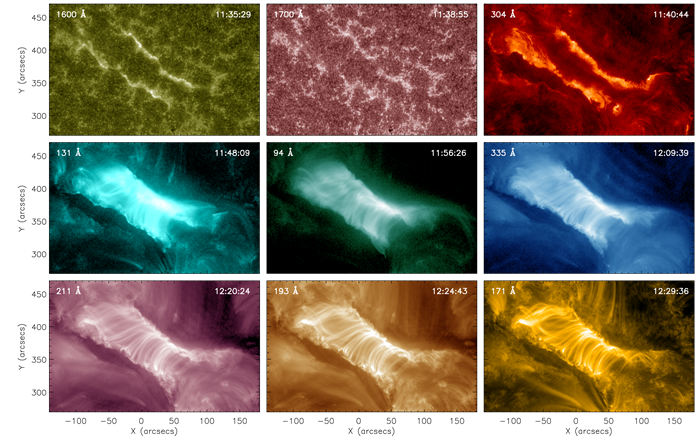|
According to the Americal Astronomical Society (AAS) Nova Highlights, “The Nature of CME-Flare-Associated Coronal Dimming”, the Astrophysical Journal paper written by Dr. CHENG Jianxia from CAS Key Laboratory of Planetary Sciences, Shanghai Astronomical Observatory (SHAO), Chinese Academy of Sciences (CAS) and Dr. QIU Jiong from Montana State University in the United States was selected as the most-downloaded papers published in AAS journals in 2016. About two hundred AAS papers were selected and among them 11 were in the area of the solar astrophysics.
Following are the contents from the AAS Nova report.

Images from the Solar Dynamics Observatory’s Atmospheric Imaging Assembly of a two-ribbon solar flare on 26 December, 2011, at the center of the Sun’s disk. Click to better see all the views in different UV/EUV channels. [Images from Cheng&Qiu 2016]
The Nature of CME-Flare-Associated Coronal Dimming
Published June 2016
Main takeaway:
The Solar Dynamics Observatory (SDO) observed a large solar eruption at the end of December 2011. Scientists Jianxia Cheng (Shanghai Astronomical Observatory and the Chinese Academy of Sciences) and Jiong Qiu (Montana State University) studied this coronal mass ejection and the associated flaring on the Sun’s surface. They found that this activity was accompanied by dimming in the Sun’s corona near the ends of the flare ribbons.
Why it’s interesting:
The process of coronal dimming isn’t fully understood, but Cheng and Qiu’s observations provide a clear link between coronal dimming and eruptions of plasma and energy from the Sun. The locations of the dimming — the footpoints of the two flare ribbons — and the timing relative to the eruption suggests that coronal dimming is caused by the ejection of hot plasma from the Sun’s surface.
How this process was studied:
There are a number of satellites dedicated to observing the Sun, and several of them were used to study this explosion. Data from SDO’s Atmospheric Imaging Assembly (which images in extreme ultraviolet) and its Helioseismic and Magnetic Imager (which measures magnetic fields) were used — as well as observations from STEREO, the pair of satellites orbiting the Sun at ±90° from SDO.
Link to the research paper:
J. X. Cheng and J. Qiu 2016 ApJ 825 37. doi:10.3847/0004-637X/825/1/37
Link to the news report:
http://aasnova.org/2016/12/29/selections-from-2016-a-connection-between-solar-explosions-and-dimming-on-the-sun/
Research contact:
CHENG Jianxia, Shanghai Astronomical Observatory, CAS, chengjx@shao.ac.cn |

